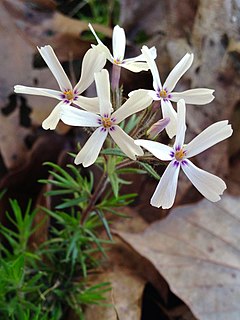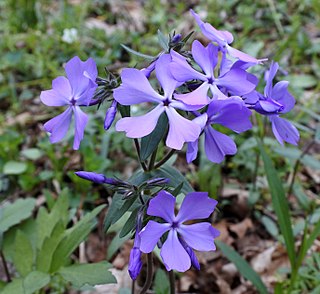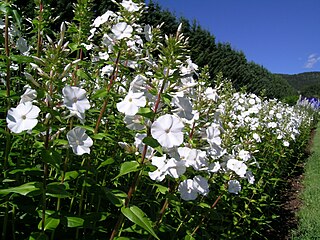
Phlox is a genus of 67 species of perennial and annual plants in the family Polemoniaceae. They are found mostly in North America in diverse habitats from alpine tundra to open woodland and prairie. Some flower in spring, others in summer and fall. Flowers may be pale blue, violet, pink, bright red, or white. Many are fragrant.

Calopogon, grass pink, is a genus of terrestrial orchids. The generic name is from Greek and means "beautiful beard", referring to the cluster of hairs adorning the labellum. The five species are native to the eastern United States, eastern Canada, Cuba and the Bahamas. The genus Calopogon is abbreviated Cpg in trade journals.

Calopogon oklahomensis, commonly known as the Oklahoma grass pink or prairie grass pink, is a terrestrial species of orchid native to the United States. It is restricted to the states of Alabama, Arkansas, Georgia, Illinois, Indiana, Iowa, Kansas, Louisiana, Minnesota, Mississippi, Missouri, Oklahoma, South Carolina, Tennessee, Texas, and Wisconsin. It is extirpated throughout most of its range. Calopogon oklahomensis is a perennial herb with flowers that are white, pink or purple, with a labellum with an apical region of yellow hairs. Flowers bloom March to July. Its habitats include coastal prairies, savannas, edges of bogs, and oak woodlands. It was described by Douglas H. Goldman in 1995.

Phlox drummondii is a flowering plant in the genus Phlox of the family Polemoniaceae. Native to Texas, it is also widely distributed in the southeastern United States, especially along public highways. P. drummondii is often used as an ornamental plant. The flowers have a wide range of colours "from white and cream through pinks, lilacs, roses, purples and reds, to almost black".

Phlox subulata the creeping phlox, moss phlox, moss pink or mountain phlox, is a species of flowering plant in the family Polemoniaceae, native to eastern and central USA, and widely cultivated. Growing to about 13 cm (5 in) high at most and covering a 50 cm (20 in) wide area, it is an evergreen perennial forming mats or cushions of hairy, linear leaves. The small, five-petaled flowers bloom in rose, mauve, blue, white, or pink in late spring to early summer.

Phlox divaricata, the wild blue phlox, woodland phlox, or wild sweet william, is a species of flowering plant in the family Polemoniaceae, native to forests and fields in eastern North America.

Iva is a genus of wind-pollinated plants in the daisy family, described as a genus by Linnaeus in 1753. Plants of this genus are known generally as marsh elders. The genus is native to North America.

Phlox paniculata is a species of flowering plant in the phlox family (Polemoniaceae). It is native to parts of the eastern and central United States. It is extensively cultivated in temperate regions as an ornamental plant and has become established in the wild in scattered locales in other regions. Common names include fall phlox, garden phlox, perennial phlox, summer phlox, and panicled phlox.

Phlox nivalis is a species of flowering plant in the Polemoniaceae family, it is commonly known as the trailing phlox, but other common names include Pineland phlox, Pine phlox, and sweet trailing. It is native to the southeastern states, along with Texas, Utah, and Michigan.
The North American Prairies Province is a large grassland floristic province within the North American Atlantic Region, a floristic region within the Holarctic Kingdom. It lies between the Appalachian Province and the Rocky Mountains and includes the prairies of the Great Plains. It is bounded by the Canadian coniferous forests on the north and the arid semideserts to the southwest. The province itself is occupied by temperate grasslands, savannas, and shrublands. Endemism is rather limited in this province, and its boundaries are vague. During the Pleistocene much of the province was glaciated.

Microsteris is a monotypic genus of flowering plants in the phlox family containing the single species Microsteris gracilis, known by the common name slender phlox.

Oenothera macrocarpa, the bigfruit evening primrose, Ozark sundrop or Missouri evening primrose, is a species of flowering plant in the evening primrose family Onagraceae, native to Mexico and the south-central United States, where it is found in calcareous prairies and limestone outcrops.

Phlox carolina, the thickleaf phlox, is a species of flowering plant in the family Polemoniaceae. It is an herbaceous perennial growing to 1.2 m (4 ft) tall by 45 cm (18 in) wide, with leaves to 13 cm (5 in) long, and purple or pink flowers in summer. The specific epithet carolina refers to its native habitat in the eastern United States. It grows in woodland edges and openings. Flowers attract bees, hummingbirds, and butterflies.
Tetraneuris scaposa is a North American species of plants in the sunflower family. It grows in the southwestern and south-central United States and northern Mexico.
Sagittaria ambigua, the Kansas arrowhead, is an aquatic plant species native to the central United States. It grows in wet areas, mostly along the shores of ponds and waterways.

Prunus gracilis, called the Oklahoma plum, sour plum, and sand plum, is native to the south-central United States.

Polemonium elegans, the elegant Jacob's-ladder, is a rare species of flowering plant in the phlox family found in the United States.

Polemonium foliosissimum, the towering Jacob's-ladder, is a rare species of flowering plant in the phlox family Polemoniaceae, native to the western United States; Arizona, Colorado, Idaho, Nevada, New Mexico, Utah and Wyoming. As its synonym Polemonium archibaldiae it has gained the Royal Horticultural Society's Award of Garden Merit.

Polemonium pauciflorum, the fewflower Jacob's-ladder, is a rare species of flowering plant in the phlox family found in the United States and Mexico.

Phlox maculata, common names wild sweetwilliam and meadow phlox, is a species of flowering plant in the family Polemoniaceae, native the eastern United States and introduced to eastern Canada. It is a perennial.
















